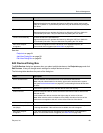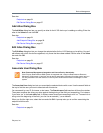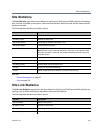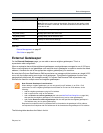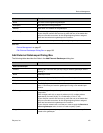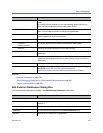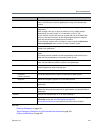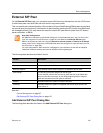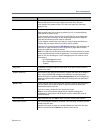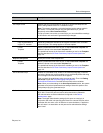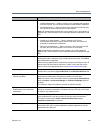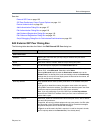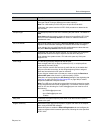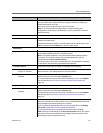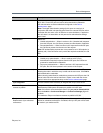
Device Management
Polycom, Inc. 106
Field Description
External SIP Peer
Enabled Clearing this check box lets you stop using an external SIP peer without
deleting it.
Name Peer name or number. Must be unique among SIP peers.
Description The text description displayed in the External SIP Peer list.
Type For a Microsoft Office Communications Server, Lync Server 2010, or Lync
Server 2013, select Microsoft. Otherwise, select Other.
Selecting Microsoft implicitly adds the Destination network value to the
Domain List (if not already there) and automatically selects the Postliminary
settings that are correct for most deployments in Microsoft environments, but
you can modify them if necessary.
Note: Selecting Microsoft enables the Lync Integration tab.
Next hop address Fully qualified domain name (FQDN), host name, or IP address of the SIP
peer.
If you specify a domain/host name, the system routes calls to this peer by
using DNS to resolve the address. The DNS server that the system uses must
contain the required records (NAPTR, SRV, and/or A/AAAA).
Note: If you are configuring a Lync 2013 SIP Peer, the Next hop address
should be the FQDN or IP address of the Lync Pool, not an individual Lync
server within a pool.
Destination network Host name, FQDN, or network domain label of the SIP peer, with or without
port and URL parameters.
If specified, this value by default replaces the non-user portion of a URL (after
the @ symbol) of the To header and Request-URI for forwarded messages,
and just the Request-URI for REGISTER messages.
If Type is set to Microsoft, this field is required, is used for the peer’s domain,
and is implicitly added to the Domain List (if not already there).
Port The SIP signaling port number. Defaults to the standard UDP/TCP port, 5060.
If the peer server is using a different port number, specify it.
Note: For a Microsoft Lync 2013 SIP peer, the port should be 5061.
If left blank, the system uses the full RFC 3263 procedure to determine the
port via DNS.
Transport type The transport protocol to use when contacting this SIP peer. The default is
UDP.
Auto detect tells the system to select the protocol using DNS as specified in
RFC 3263, and is not valid if Next hop address is a numeric IP address
instead of a host/domain name.
Use route header Add a Route header with the peer’s Next hop address value to the message.
Applies to both forwarded messages and external REGISTER messages.
If not selected, the only valid Request-URI configurations are those that use
the peer's Next hop address value for the URI host.



